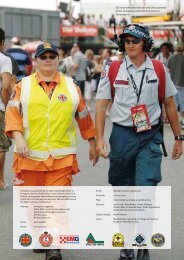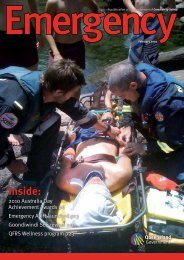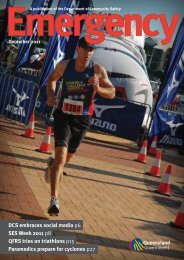Photo by Michael Marston - Department of Emergency Services ...
Photo by Michael Marston - Department of Emergency Services ...
Photo by Michael Marston - Department of Emergency Services ...
You also want an ePaper? Increase the reach of your titles
YUMPU automatically turns print PDFs into web optimized ePapers that Google loves.
Aero-medical resources critical<br />
for envenomation responses<br />
It is no secret that Australia has a<br />
reputation for its deadly snakes,<br />
spiders and marine stingers, yet in<br />
reality, the number <strong>of</strong> casualties caused<br />
<strong>by</strong> these venomous creatures is low.<br />
On average, one or two people annually<br />
die from snake bites across the country,<br />
despite the fact that more than 3000<br />
bites are recorded each year.<br />
The incidence <strong>of</strong> marine envenomations<br />
is even lower, despite the popularity <strong>of</strong><br />
Australia’s world-famous beaches.<br />
Just a handful <strong>of</strong> deaths from stingrays<br />
have been recorded in Australia, while 68<br />
deaths have been caused <strong>by</strong> box jellyfish<br />
since 1883, and just two <strong>by</strong> Irukandji.<br />
However, despite this low rate, the vast<br />
physical size <strong>of</strong> Queensland means that<br />
a bite or sting in a rural or remote area<br />
can be life-threatening, and requires<br />
urgent action.<br />
“Most snake bites, with correct first<br />
aid, are survivable. A rapid medical<br />
response will increase the chances,<br />
but correct identification and the<br />
administration <strong>of</strong> antivenom are<br />
critical,” Queensland Ambulance<br />
Service Chief Medical Director<br />
Stephen Rashford said.<br />
To help emergency services providers<br />
respond swiftly to such incidents,<br />
the State relies on the Queensland<br />
<strong>Emergency</strong> Medical System (QEMS)<br />
– an integrated and coordinated<br />
system <strong>of</strong> care for the acutely ill and<br />
injured, with access to 17 aero-medical<br />
resources spread across the State.<br />
With 18 pilots, 16 aircrew <strong>of</strong>ficers, 15<br />
rescue crew <strong>of</strong>ficers, four engineers and<br />
four admin staff, EMQ Rescue is one <strong>of</strong><br />
the most sophisticated, well-resourced<br />
services, providing state-<strong>of</strong>-the-art<br />
equipment and medical care<br />
across Queensland.<br />
This network <strong>of</strong> helicopters is activated<br />
regularly to retrieve Queenslanders that<br />
have been bitten <strong>by</strong> some <strong>of</strong> the world’s<br />
deadliest creatures.<br />
So when a two-year-old presents in<br />
the Atherton Tablelands with a severe<br />
headache, nausea, unusual scratch<br />
marks on her left leg and localised<br />
bleeding, the response is activated<br />
via the QEMS Coordination Centre<br />
at Spring Hill in Brisbane.<br />
Her condition is monitored at the<br />
Mareeba Base Hospital, samples<br />
from the bite site are analysed using<br />
the highly accurate Venom Detection<br />
Kit and doctors determine she has<br />
been struck <strong>by</strong> a King Brown, one <strong>of</strong><br />
Australia’s most common snakes.<br />
16 EMERGENCY October 2006 www.emergency.qld.gov.au






